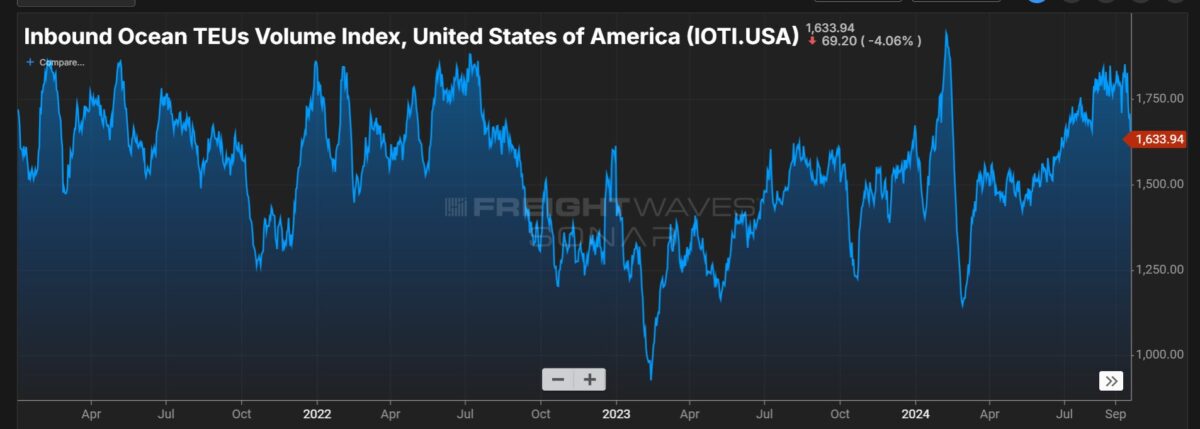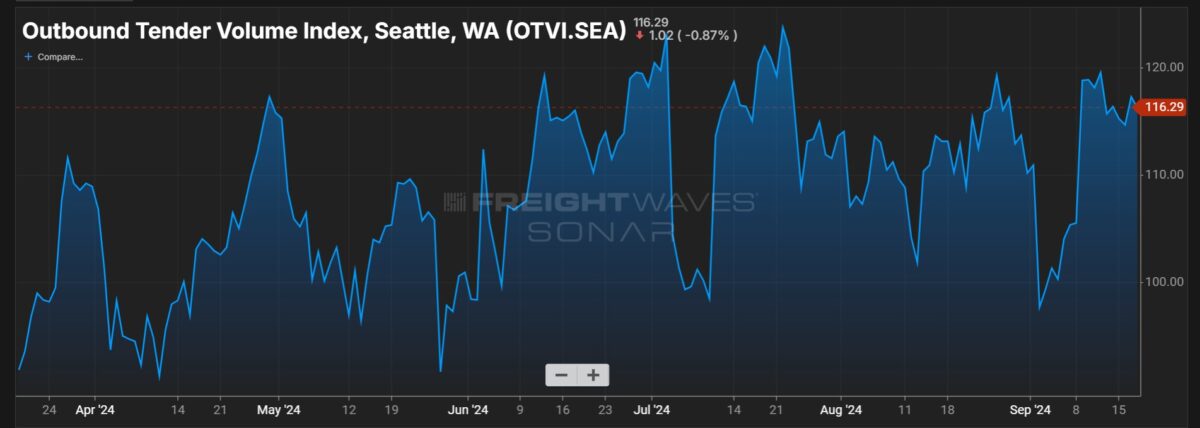The State of Freight webinar for September featured discussion of something that doesn’t happen too often: a significant strike by dockworkers.
The International Longshoremen’s Association is threatening to strike East and Gulf Coast ports on Oct. 1, raising the prospect of supply chain disruptions. It became the lead topic of discussion on Thursday’s webinar as FreightWaves CEO Craig Fuller sat down with Zach Strickland, the company’s head of market intelligence.
Here are five takeaways from this month’s webinar, which can be accessed here.
Tough timing for a strike
Fuller said the potential timing of a strike is “the important thing.” “If this was going to happen in April, it can be disruptive, but we’re talking about October and a lot of those imports that are coming in October are bound for holiday sales,” he said.
The timing of a container coming in starting in October makes delivery for the holidays a tight squeeze, he said. A container arriving on the East Coast by Oct. 10 is going to be able to get into the supply chain in time for holiday delivery. If the container arrives by Nov. 15, “now you’re pushing it, but you’ve got about a month where those products can clear customs.”
A strike would be “massively disruptive to supply chains” if it occurs, Fuller said. He specifically cited areas that might be hit hard, such as the network of warehouses in Pennsylvania’s Lehigh Valley, taking in a lot of products imported into the Port of Newark, New Jersey. “So those consumers, if this goes on for long, could see disruptions,” he said.
The big volumes coming into the ports
Whether it’s preparing for a possible strike or the threat of big tariffs should Donald Trump return to the White House, import volumes coming into the nation’s ports already are at strong levels.
Strickland cited data from the SONAR Inbound TEU Volume Index (IOTI.USA in SONAR). “What’s shocking to me about this chart is that we are on par in the last month or so with the COVID-era shipping,” Strickland said, citing a period with massive backups of container ships waiting to offload, particularly on the West Coast. He noted the threat of the ILA strike as one possible reason but also said disruptions out of the Red Sea from Houthi attacks on shipping might have spurred an increase in imports that would have come around South Africa’s Cape of Good Hope to avoid the Red Sea.
“The facts are always a little bit more challenging to figure out whether or not this is related to labor events or geopolitical events,” Fuller said, adding the tariff threat into the latter category.

But volumes on the ground aren’t keeping up
As Strickland noted, an import that arrives in the U.S. has three options: It can go into a warehouse, get on a truck to a final destination or get on a train. The big numbers in the IOTI are not being matched in the Outbound Tender Volume Index (OTVI.USA in SONAR). For example, the OTVI.USA was at 123.78 on July 22. On Wednesday, it was 116.29.
Fuller had theories as to why. Fuller said it could be a sign of more efficient operations arising out of changes brought about by the wild freight market of 2022. “Those companies already run a pretty sophisticated logistics network, where they already have dedicated trucking, they already have their linehaul services between their distribution centers,” he said. “My theory is that eventually that volume does hit the trucking business. It just hasn’t yet.”

What constitutes normal?
Freight markets have been on a wild ride in recent years. In 2018, there was talk that it was one of the greatest freight markets ever. That was followed by a weak 2019, the short-term collapse because of COVID and the shock of a freight market that began to boom long before COVID was under control – a bull market that continued into 2022. So what’s normal these days?
Fuller suggested that the current market is trending toward normal. One reason: It has been doing what might be expected. For example, during International Roadcheck in May, capacity as measured by the Outbound Tender Reject Index tightened as many drivers stayed home. “I think Roadcheck Week was the first time we saw it move the freight market in two years,” Fuller said. There also was the normal drop in both capacity and volume during Memorial Day, the July Fourth holiday and Labor Day.
“And what that tells me is that while it’s not a great year, we are seeing a normalization of the market. When we talk about normal, are we talking about a market that was like 2021? Are we talking about a market like 2018?”
His definition of normal is that seasonality should impact markets, and that is beginning to happen. “Events do drive the market,” Fuller said. “And I think we are certainly seeing that this year.”
The possibility of another supply chain crisis
Fuller cited recent comments by an economist who looked at the ocean import volumes and saw the potential for another supply chain crisis like 2021 and into 2022, with the enormous backup of ships and the inability to keep deliveries moving. “What was causing the supply chain crisis then was the massive level of uncertainty, and everybody was ordering everything and you just had massive chaos,” Fuller said.
But to help ensure that wasn’t going to happen again, a huge amount of money has been spent on technology, “whether it’s visibility systems, robotic systems, all of that stuff,” Fuller said.
Another factor weighing against a return to the craziness of a few years ago is the fact that jobs were turning over massively, but there’s been more of a return to normal since then, Fuller said. During the COVID crisis, he said, “it wasn’t just your dockworkers that weren’t showing up. It wasn’t just your truck drivers. You were losing people who had domain expertise in logistics, and people who had never been in logistics were having to learn on the job.”
Even with a strike on the East Coast, Fuller said, “this is a much more orderly set of conditions.”
More articles by John Kingston
Another nuclear verdict in trucking: $160M award against Daimler
Trimble and Platform Science pushed hard to get deal done before Vegas meeting
Supreme Court to hear case of truck driver who failed CBD-related drug test








James Bauman dba Kirplopus MC 895097
How much of this inbound freight from China, etc; is kept out of carriers reach via private fleets? How much of this is Walmart, Amazon, etc? I suspect significant amounts of inbound freight is hauled via private fleets and intermodal; thus not bumping up truckload #’s for legacy & smaller carriers. Aren’t Walmart & Amazon the two biggest US sellers?